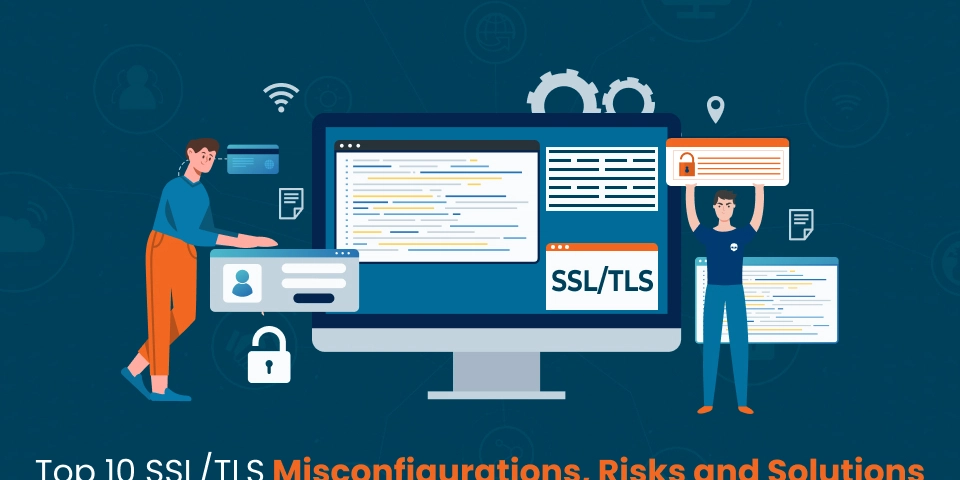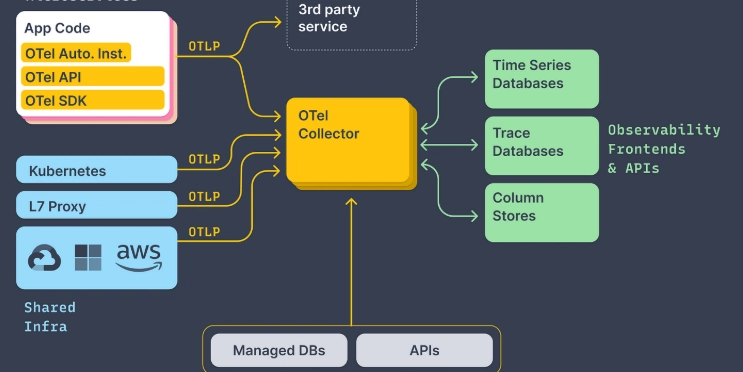Top 10 SSL/TLS Setup Mistakes and How to Correct Them
SSL/TLS encryption protects online communication, but minor configuration errors can create serious security risks. Misconfigured SSL/TLS settings can expose sensitive data, leaving websites vulnerable to cyberattacks. 71% of organization's reported SSL/TLS-related attacks last year. According to OWASP, a staggering 90% of applications tested in 2021 had some form of misconfiguration. These errors are outdated protocols and weak cipher suites. That can make weak encryption, and attackers could exploit these security flaws. Understanding and addressing SSL/TLS misconfigurations is important to maintaining a secure and strong online presence. These misconfigurations have been exploited by hackers for a long time. They intercept data traffic, perform man-in-the-middle attacks, or downgrade encryption protocols. Some of the common mistakes are using expired or self-signed certific ates, enabling weak ciphers, and failing to enforce HTTPS properly. These could lead to user data breaches, trust damage, and regulatory penalties. In this blog, we are going to see the top 10 SSL/TLS misconfigurations. What is SSL and TLS? Secure Sockets Layer (SSL) and Transport Layer Security (TLS), are cryptographic protocols designed to secure communication over the internet. When a user visits a web site, the server sends the data to the user's browser, and all this data passes through different network devices across the internet. To protect this data so only the user to whom it belongs can get this data, the SSL and TLS protocol is used, which encrypts data transferred between clients (such as web browsers) and servers. It also gives data integrity, showing that no 3rd person can do any small changes to this data in middleware. Netscape introduced the Secure Sockets Layer (SSL) protocol in 1994 to address the growing need for secure data transmission over the internet, particularly for web browsers and other TCP-based protocols. However, SSL 1.0 was never officially released due to significant security vulnerabilities. The first public version, SSL 2.0, was launched in 1995, followed by the final iteration, SSL 3.0, which was released in November 1996. As SSL became outdated due to security vulnerabilities, Transport Layer Security (TLS) was introduced as its successor. TLS has four versions, TLS 1.0, TLS 1.1, TLS 1.2 and TLS 1.3, each version has better than SSL. It has many advantages over SSL, such as it supports strong and modern cryptography, Improved Handshake Process, Better Authentication, Protection Against Known Attacks and Session Resumption. Nowadays TLS 1.2 and TLS 1.3 are widely used over the internet. Advantages of TLS Over SSL Stronger Encryption - TLS supports modern cryptographic algorithms, such as AES-GCM and ChaCha20, which provide better security than older SSL ciphers. Improved Handshake Process - TLS reduces latency by optimizing the handshake process, making secure connections faster. Better Authentication - Supports more robust authentication mechanisms, such as certificate pinning and Perfect Forward Secrecy (PFS). Protection Against Known Attacks - Fixes vulnerabilities found in SSL, such as POODLE, BEAST, and DROWN. Session Resumption - TLS improves session resumption techniques, reducing overhead and improving performance for repeated connections. About SSL/TLS Protocols It works on a handshake process where the client and server agree on the encryption algorithms and keys to be used for the session. These protocols establish a secure connection by utilizing a combination of encryption algorithms, key exchange methods, and digital certificates. Encryption algorithms, such as AES, ensure that data is encrypted and can only be decrypted by the intended recipient. Key exchange mechanisms, like Diffie-Hellman, facilitate the secure transfer of cryptographic keys between the client and server. Additionally, digital certificates, issued by trusted Certificate Authorities (CAs), authenticate the identities of both parties, further enhancing the security of the communication. The Top 10 SSL/TLS Misconfigurations & Solutions Here are the top 10 SSL/TLS misconfigurations, their risks, and how to fix them. Using Weak or Deprecated Cipher Suites It violates many top security standards, such as NIST, the problem here is that older algorithms use small key sizes, which can be easily broken with today's computation power. It also lacks Perfect Forward Secrecy (PFS), meaning that if a private key is compromised, all past communications using that key can be decrypted. Using weak or deprecated cipher suites is a major security risk. These outdated cryptographic algorithms can be exploited by attackers to decrypt sensitive data, perform man-in-the-middle (MITM) attacks, or compromise the confidentiality and integrity of communications. The encryption algorithms like RC4 or hash functions based on MD5 can leave your site vulnerable to attacks such as BEAST (Browser Exploit Against SSL/T

SSL/TLS encryption protects online communication, but minor configuration errors can create serious security risks. Misconfigured SSL/TLS settings can expose sensitive data, leaving websites vulnerable to cyberattacks.
71% of organization's reported SSL/TLS-related attacks last year. According to OWASP, a staggering 90% of applications tested in 2021 had some form of misconfiguration.
These errors are outdated protocols and weak cipher suites. That can make weak encryption, and attackers could exploit these security flaws. Understanding and addressing SSL/TLS misconfigurations is important to maintaining a secure and strong online presence.
These misconfigurations have been exploited by hackers for a long time. They intercept data traffic, perform man-in-the-middle attacks, or downgrade encryption protocols. Some of the common mistakes are using expired or self-signed certific
ates, enabling weak ciphers, and failing to enforce HTTPS properly. These could lead to user data breaches, trust damage, and regulatory penalties. In this blog, we are going to see the top 10 SSL/TLS misconfigurations.
What is SSL and TLS?
Secure Sockets Layer (SSL) and Transport Layer Security (TLS), are cryptographic protocols designed to secure communication over the internet. When a user visits a web site, the server sends the data to the user's browser, and all this data passes through different network devices across the internet.
To protect this data so only the user to whom it belongs can get this data, the SSL and TLS protocol is used, which encrypts data transferred between clients (such as web browsers) and servers. It also gives data integrity, showing that no 3rd person can do any small changes to this data in middleware.
Netscape introduced the Secure Sockets Layer (SSL) protocol in 1994 to address the growing need for secure data transmission over the internet, particularly for web browsers and other TCP-based protocols.
However, SSL 1.0 was never officially released due to significant security vulnerabilities. The first public version, SSL 2.0, was launched in 1995, followed by the final iteration, SSL 3.0, which was released in November 1996.
As SSL became outdated due to security vulnerabilities, Transport Layer Security (TLS) was introduced as its successor. TLS has four versions, TLS 1.0, TLS 1.1, TLS 1.2 and TLS 1.3, each version has better than SSL.
It has many advantages over SSL, such as it supports strong and modern cryptography, Improved Handshake Process, Better Authentication, Protection Against Known Attacks and Session Resumption. Nowadays TLS 1.2 and TLS 1.3 are widely used over the internet.
Advantages of TLS Over SSL
- Stronger Encryption - TLS supports modern cryptographic algorithms, such as AES-GCM and ChaCha20, which provide better security than older SSL ciphers.
- Improved Handshake Process - TLS reduces latency by optimizing the handshake process, making secure connections faster.
- Better Authentication - Supports more robust authentication mechanisms, such as certificate pinning and Perfect Forward Secrecy (PFS).
- Protection Against Known Attacks - Fixes vulnerabilities found in SSL, such as POODLE, BEAST, and DROWN.
- Session Resumption - TLS improves session resumption techniques, reducing overhead and improving performance for repeated connections.
About SSL/TLS Protocols
It works on a handshake process where the client and server agree on the encryption algorithms and keys to be used for the session.
These protocols establish a secure connection by utilizing a combination of encryption algorithms, key exchange methods, and digital certificates. Encryption algorithms, such as AES, ensure that data is encrypted and can only be decrypted by the intended recipient.
Key exchange mechanisms, like Diffie-Hellman, facilitate the secure transfer of cryptographic keys between the client and server. Additionally, digital certificates, issued by trusted Certificate Authorities (CAs), authenticate the identities of both parties, further enhancing the security of the communication.
The Top 10 SSL/TLS Misconfigurations & Solutions
Here are the top 10 SSL/TLS misconfigurations, their risks, and how to fix them.
Using Weak or Deprecated Cipher Suites
It violates many top security standards, such as NIST, the problem here is that older algorithms use small key sizes, which can be easily broken with today's computation power. It also lacks Perfect Forward Secrecy (PFS), meaning that if a private key is compromised, all past communications using that key can be decrypted.
Using weak or deprecated cipher suites is a major security risk. These outdated cryptographic algorithms can be exploited by attackers to decrypt sensitive data, perform man-in-the-middle (MITM) attacks, or compromise the confidentiality and integrity of communications.
The encryption algorithms like RC4 or hash functions based on MD5 can leave your site vulnerable to attacks such as BEAST (Browser Exploit Against SSL/TLS), POODLE (Padding Oracle On Downgraded Legacy Encryption), Logjam (Weak Diffie-Hellman Key Exchange), and SWEET32 (Birthday Attack on 64-bit Block Ciphers).
Flaws in cipher block chaining (CBC) within SSL/TLS protocols can result in ciphertext collisions, potentially enabling attackers to decrypt and recover sensitive plaintext data.
How to Test?
Here are some methods which check if your site is affected by this misconfiguration or not.
Method 1: You can use SSL online tools to check your site.
Method 2: You can use command line tools such as Nmap and OpenSSL.
For OpenSSL run this command:
openssl s_client -connect example.com:443 -cipher LOWFor Nmap use:
nmap --script ssl-enum-ciphers -p 443 example.comHow to Fix it?
Update your server configuration to implement secure, modern cipher suites such as AES-GCM with SHA-256, while eliminating outdated and deprecated options.
Follow these steps to fix in Apache and CentOS/RHEL.
Step 1: Open the configuration file
For Apache: " sudo nano /etc/apache2/apache2.conf "
For CentOS/RHEL: " sudo nano /etc/httpd/conf/httpd.conf "
Step 2: Add or update the following SSL configuration.
SSLProtocol -SSLv2 -SSLv3 -TLSv1 -TLSv1.1 +TLSv1.2 +TLSv1.3
SSLCipherSuite HIGH:!aNULL:!MD5:!RC4:!3DES:!SHA1
SSLHonorCipherOrder onStep 3: Save ( Ctrl + X, then Y, then Enter ) the configuration file and restart the server for Apache " sudo systemctl restart apache2 " and for CentOS/RHEL " sudo systemctl restart httpd ".
Read the full article - https://cheapsslweb.com/blog/top-10-ssl-tls-misconfigurations-risks-and-its-solutions/




































































































































































![[The AI Show Episode 145]: OpenAI Releases o3 and o4-mini, AI Is Causing “Quiet Layoffs,” Executive Order on Youth AI Education & GPT-4o’s Controversial Update](https://www.marketingaiinstitute.com/hubfs/ep%20145%20cover.png)






























































































































![[FREE EBOOKS] Learn Computer Forensics — 2nd edition, AI and Business Rule Engines for Excel Power Users & Four More Best Selling Titles](https://www.javacodegeeks.com/wp-content/uploads/2012/12/jcg-logo.jpg)





![From Art School Drop-out to Microsoft Engineer with Shashi Lo [Podcast #170]](https://cdn.hashnode.com/res/hashnode/image/upload/v1746203291209/439bf16b-c820-4fe8-b69e-94d80533b2df.png?#)






































































































(1).jpg?#)
































_Inge_Johnsson-Alamy.jpg?width=1280&auto=webp&quality=80&disable=upscale#)












































































































![Apple to Split iPhone Launches Across Fall and Spring in Major Shakeup [Report]](https://www.iclarified.com/images/news/97211/97211/97211-640.jpg)
![Apple to Move Camera to Top Left, Hide Face ID Under Display in iPhone 18 Pro Redesign [Report]](https://www.iclarified.com/images/news/97212/97212/97212-640.jpg)
![Apple Developing Battery Case for iPhone 17 Air Amid Battery Life Concerns [Report]](https://www.iclarified.com/images/news/97208/97208/97208-640.jpg)
![AirPods 4 On Sale for $99 [Lowest Price Ever]](https://www.iclarified.com/images/news/97206/97206/97206-640.jpg)































![[Updated] Samsung’s 65-inch 4K Smart TV Just Crashed to $299 — That’s Cheaper Than an iPad](https://www.androidheadlines.com/wp-content/uploads/2025/05/samsung-du7200.jpg)




































































